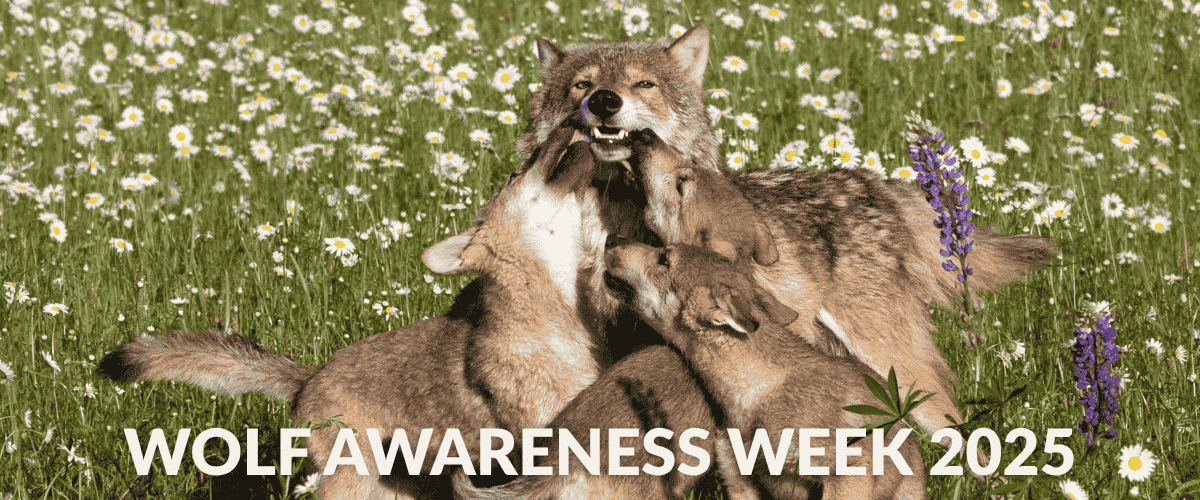Wolf Awareness Week 2025 is here.

WOLF AWARENESS WEEK 2025:
Honoring Wolves, Exposing Broken Wildlife Governance, and Fighting for a Just Future
Wolf Awareness Week 2025 is here. Every third week of October, we celebrate Wolf Awareness Week — a tradition that began in 1996 when President Bill Clinton first recognized the occasion as a time to replace fear with understanding. This week is meant to honor wolves, one of North America’s most essential keystone species, and to shine a light on their ecological role and their ongoing fight for survival.
But to be honest — this year, it’s hard to feel celebratory even though we’re celebrating the 30th anniversary of wolf reintroduction into Yellowstone and central Idaho.
Across the country, wolves are being slaughtered at staggering rates under the banner of “management.” They are vilified in the media, scapegoated by industry, and failed by outdated state wildlife governance systems that treat them not as living beings essential to ecosystems, but as problems to be “controlled.”
From the Northern Rockies to the Southwest, the fight for wolves is a fight against entrenched political and economic power. And that’s exactly why reforming state wildlife governance is essential — not just for wolves, but for the health of every ecosystem they shape.
Wolves: A Keystone Species in Crisis
Wolves are not just another wildlife species. They are a keystone species and apex carnivore, meaning their presence — or absence — ripples through entire ecosystems. When wolves return, landscapes heal: ungulate populations rebalance, vegetation recovers, rivers stabilize, and biodiversity thrives. This is not romanticism; it’s science.
Yet, despite this well-established ecological reality, wolves remain under siege:
-
In the Northern Rockies, states like Montana and Idaho are in the midst of relentless killing sprees, setting quotas that allow for the slaughter of hundreds of wolves annually. These decisions are driven not by science, but by political pressure from livestock and trophy hunting interests.
-
In the Great Lakes region, state politicians are eagerly waiting for federal delisting to resume unscientific wolf hunts.
-
In Colorado and California, where wolves are making fragile returns, they face a coordinated disinformation campaign by Big Ag to turn the public against them.
-
Mexican gray wolf populations are still on the brink, with individuals dying over and over again from government-sanctioned “management” and illegal poaching.
-
And the wild population of red wolf numbers fewer than 25 individuals, confined to a tiny pocket of habitat in North Carolina.
This is not a failure of science. It’s a failure of governance.
Wolves are persecuted not because they are a biological threat to ecosystems, but because they are a political inconvenience to industries that profit from their absence. Across most states, wildlife commissions are stacked with livestock and trophy hunting interests, and the agencies that should be stewards of biodiversity are instead beholden to extractive politics.
This is why Wildlife for All is fighting to transform state wildlife governance systems. Real democracy in wildlife management means giving all people — not just a politically connected few — a voice in how wildlife is managed. It means grounding decisions in science, ethics, and ecological health, not political favors or cultural resentments.
Wolf Awareness Week isn’t just a time to celebrate wolves. It’s a time to name the systems that are killing them.
 Bright Spots in a Dark Landscape
Bright Spots in a Dark Landscape
Even in the face of relentless persecution, there are glimmers of hope:
-
A federal court ruled that U.S. Fish and Wildlife Service improperly delisted Northern Rockies wolves, forcing a reassessment of the threats they face.
-
Conservation groups are challenging Montana’s record-high quota of 558 wolves for the 2025–26 season.
-
In North Carolina, wildlife crossings are being built along Highway 64 to help save the last red wolves in the wild.
-
New Mexico’s governor fired a wildlife commissioner over her ties to anti-wolf groups — a rare example of accountability.
-
Grassroots coexistence work in Colorado is shifting the narrative and building real solutions with ranchers.
-
Three new wolf packs were confirmed earlier this year in California.
These victories don’t erase the threats — but they remind us why we fight.
A new national survey shows that the American public overwhelmingly supports continued protections for gray wolves under the Endangered Species Act — including 75% of rural residents in wolf states and 79% of farmers and ranchers. For every person who strongly opposes protecting wolves, more than nine strongly support it. In a moment when political efforts to strip federal protections are gaining traction, this broad public backing is a powerful reminder that most Americans want wolves — and the wild places they depend on — to endure.
Wolf Awareness Week 2025 should not be about celebrating the fact that wolves still exist in spite of us. It should be about building a future where they thrive because of us — because we chose to evolve our governance, challenge entrenched power, and align our policies with science and justice.
Wolves deserve more than “management.” The language we use matters. Wolves are not a “resource” to be managed for recreational killing. They are sentient beings with intrinsic value, integral to the functioning of wild ecosystems.
How to Take Action During Wolf Awareness Week 2025
-
Speak up: Contact your state wildlife commission and demand science-based protections for wolves if you live in a state with wolves.
-
Educate: Share credible information that counters fearmongering and myths.
-
Organize: Join efforts to reform state wildlife governance so wolves — and all wildlife — have a future.
-
Support: Grassroots coexistence programs, legal challenges, and advocacy campaigns need public backing.
Wolves have survived centuries of eradication campaigns. Their endurance is a testament to their strength. But survival is not the same as justice.
This Wolf Awareness Week, let’s honor wolves not with platitudes, but with power-building — the kind that can transform broken systems and create a future where wolves are not fighting for scraps of safety, but thriving as the ecological keystones they are.


